
Photo from wikipedia
Viruses have evolved diverse strategies to hijack the cellular gene expression system for their replication. The poly(A) binding proteins (PABPs), a family of critical gene expression factors, are viruses’ common… Click to show full abstract
Viruses have evolved diverse strategies to hijack the cellular gene expression system for their replication. The poly(A) binding proteins (PABPs), a family of critical gene expression factors, are viruses’ common targets. ABSTRACT Viruses have evolved diverse strategies to hijack the cellular gene expression system for their replication. The poly(A) binding proteins (PABPs), a family of critical gene expression factors, are viruses’ common targets. PABPs act not only as a translation factor but also as a key factor of mRNA metabolism. During viral infections, the activities of PABPs are manipulated by various viruses, subverting the host translation machinery or evading the cellular antiviral defense mechanism. Viruses harness PABPs by modifying their stability, complex formation with other translation initiation factors, or subcellular localization to promote viral mRNAs translation while shutting off or competing with host protein synthesis. For the past decade, many studies have demonstrated the PABPs’ roles during viral infection. This review summarizes a comprehensive perspective of PABPs’ roles during viral infection and how viruses evade host antiviral defense through the manipulations of PABPs.
Journal Title: Journal of Virology
Year Published: 2022
Link to full text (if available)
Share on Social Media: Sign Up to like & get
recommendations!